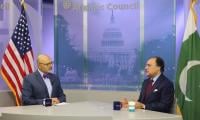Blindly driven by economic interests, four different US presidents over the last two decades have taken foolish decisions. Recent events suggest that Trump has followed in their footsteps and made even more foolish choices.
On September 25, 1996, during the 51st session of the UN General Assembly, Bill Clinton signed the Comprehensive Test Ban Treaty, an agreement aimed at banning all nuclear testing. In his address, Clinton said that his biggest foreign policy achievement was “the longest-sought, hardest-fought prize in arms control history”.
Clinton boasted that the signatures of the five declared nuclear powers, along with a majority of other countries, “will immediately create an international norm against nuclear testing even before the treaty formally enters into force”. With reference to India’s refusal to sign the treaty because the treaty failed to set a date for the total elimination of nuclear weapons, Clinton said that: “some have complained that it does not mandate total nuclear disarmament by a certain date. I would say to them, do not forsake the benefits of this achievement by ignoring the tremendous progress we have already made toward that goal”.
At the time, the Clinton administration had hoped that India could be convinced to sign the treaty before it was expected to go into effect. The US had credible intelligence of India’s clandestine nuclear weapons programme and was aware that without India’s signature the treaty could not enter into force.
In May 1998, just a few short months before the treaty was expected to go into effect, India detonated five nuclear bombs, upending Clinton’s “longest-sought and hardest-fought” achievement in foreign policy and arms control history. In a televised speech following the Indian nuclear explosions, Clinton said that: “India’s actions threaten stability in Asia and challenge the firm international consensus to stop all nuclear testing”.
Clinton ought to have acted in time to dismantle India’s secret nuclear weapons programme and enact harsh sanctions after it had exploded five nuclear devices.
Roughly seven years later, on July 18, 2005, George Bush bizarrely announced the US-India Civil Nuclear Agreement. This agreement provided India a complete waiver from all nonproliferation obligations. In 2008, the Bush administration successfully secured a waiver for India to participate in international nuclear commerce from the Nuclear Suppliers Group, an export-control regime that had been formed mainly in response to India’s first nuclear test in 1974.
In hoping that India would purchase American nuclear reactors to meet its energy needs, Bush completely disregarded all nonproliferation regimes and paved the way for India to vertically proliferate without any checks.
On January 24, 2015 – roughly seven years after the Bush administration secured the NSG waiver for India – Obama foolishly decided to announce plans for billions of dollars worth of nuclear trade with India, which also included a commitment to deepen defence ties with a view to establish a lasting strategic partnership.
The very same year, Adrian Levy’s report that was written for the Center for Public Integrity – a nonprofit, nonpartisan investigative news organisation in Washington DC – exposed a top-secret nuclear city in India, a whole city designed just to produce thermonuclear weapons. A year later in 2016, an Al Jazeera investigation titled, ‘India’s embarrassing North Korean connection’, highlighted India’s role in helping train North Korean scientists who went on to help develop North Korea’s nuclear weapons and its ballistic missiles.
Last August, US President Trump signed the Countering America’s Adversaries Through Sanctions Act (Caatsa) into law. This is a legislation aimed at Russia for the 2014 annexation of Crimea from Ukraine, the country’s involvement in the Syrian civil war, and its attempts to meddle in the 2016 US presidential election. The law was designed to stop countries from trading with Russia’s defence and intelligence sectors and seeks to punish any country caught trading with secondary sanctions.
During the Obama administration, similar sanctions existed against Iran. Countries caught trading with Iran were threatened with secondary sanctions. But this didn’t stop India from importing oil and moving forward with an agreement to build the Chabahar Port for Iran. Despite India’s violations, Obama didn’t impose any secondary sanctions on the country.
Until last week, it seemed that Trump had managed to escape the foolishness of his predecessors. It seemed certain that if India continued to trade in Russian arms, it would face secondary sanctions. But last week Trump proved people wrong as his decision to seek a waiver from Congress for India with regard to Caatsa made headlines.
If this waiver is granted – as it is expected – it will open doors for India to continue importing arms from Russia, including the S-400 long-range surface to air missile system. This could weaken Asia’s already fragile stability.
The writer is a defence analyst in Washington DC. Twitter: @umarwrites
As usual, any such deal, aiming to resuscitate ailing economy, brings to fore urge and resolve to halt further...
A representational showing sticky notes on a board. — Unsplash/FileThere are some common themes from the lives...
Whether the Daanish Schools effort has been able to live up to its principles or not may be debatable
According to the federal government, last year 653,100 people experienced homelessness on a single night in America
Another advantage for Pakistan is the enhanced teledensity and internet penetration
Both media spheres need to dovetail in amplifying the urgency of addressing climate change at the local, national, and...







